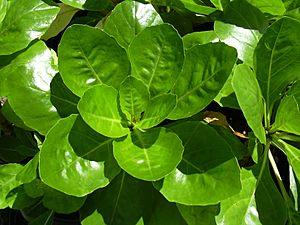Brighamia rockii facts for kids
Quick facts for kids Brighamia rockii |
|
|---|---|
 |
|
| Conservation status | |
| Scientific classification | |
| Genus: |
Brighamia
|
| Species: |
rockii
|
Brighamia rockii, also known as the Molokai ohaha or Pua ʻala in Hawaiian, is a special flowering plant. It belongs to the bellflower family. This plant is found only on the island of Molokaʻi in Hawaii. It grows on rocky cliffs near the ocean, up to about 470 meters (1,540 feet) high.
Contents
About the Molokai Ohaha
The Molokai ohaha is a unique plant from Hawaii. It is found only on the island of Molokaʻi. This means it is endemic to that island. It likes to grow in moist shrublands and forests. You can often spot it on rocky cliffs. These cliffs are usually on the windy side of the island. The plant can grow from sea level up to about 470 meters (1,540 feet) high.
Some other plants that grow near the Pua ʻala include ʻōhiʻa lehua, alaheʻe, lama, ʻūlei, and naupaka. These plants create a special home for the Molokai ohaha.
What it Looks Like
The Pua ʻala can grow quite tall, from about 1 to 5 meters (3 to 16 feet). It has a thick, trunk-like stem that gets thinner towards the top. Its leaves are oval-shaped. They are usually 6 to 22 centimeters (2 to 9 inches) long. The leaves grow in a circle at the very top of the plant, like a rosette.
Each group of flowers on the plant has three to eight white flowers. These flowers are shaped like trumpets. They are very pretty and stand out against the green leaves.
Why it Needs Our Help
Sadly, the Pua ʻala has disappeared from the islands of Lānaʻi and Maui. This means it is extirpated from those places. It is now only found on Molokaʻi. There are fewer than 200 of these plants left in the wild. Because of this, it is listed as an endangered species. This means it is at a very high risk of disappearing forever.
Threats to Survival
Several things make it hard for the Pua ʻala to survive.
- Habitat Loss: Its natural home is being destroyed.
- Alien Plants: Plants from other places are growing where the Pua ʻala should be. They take up space and resources.
- Animals: Goats and deer eat the plants, which harms them.
- Lack of Pollinators: The plant needs certain insects to help its flowers make seeds. There are not enough of these insects anymore.
Helping the Plant Survive
Scientists and conservationists are working hard to protect the Pua ʻala. The plant used to be pollinated by a native Hawaiian hawk moth. But this moth is now very rare. Today, an introduced hawk moth called Daphnis nerii helps to pollinate the plant.
Some Pua ʻala plants have been grown by people. These plants are then put back into their natural home on Molokaʻi. This helps to increase the number of plants in the wild. These efforts are important to save this special Hawaiian plant.


